Hello and welcome to Japan in ‘lockdown’, which is nothing at all like Australia in lockdown, with very few actual restrictions imposed and the various governments – local and national – almost begging people to behave sensibly. I am noting a certain increased level of anxiety in the language being used by MPs, although apparently the PM is still more concerned about the economy than the virus and has only increased the areas covered in the state of emergency due to what I suspect must have been very strong language from the expert panel. Thank goodness they are now pushing their point more forcefully, otherwise this would likely drag on forever.
The state of emergency has also been extended to the end of May, which is also a good thing. The other good news in relation to The virus is on the vaccine front – the government has asked the military to help by setting up mass vaccination centres in Tokyo and Osaka, and today they are starting to take bookings, with the first vaccinations in Osaka commencing today (Tokyo will commence 31 May)! Apparently people from Kyoto and Hyogo will be able to travel to Osaka to be vaccinated starting in the second week of June, if we really want to.
Now, to something a little lighter…the weather! Yes, I know, I am somewhat fascinated by the weather, and living here you do experience many different types of weather patterns, especially because the weather here can come from nearly any direction, quite unlike living in Adelaide where it nearly always comes from a westerly direction. The interesting news at the moment is that yesterday the Japan Meteorological Agency declared that the rainy season was well and truly open in western Japan, which includes the Kansai region.
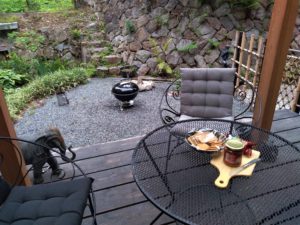
We managed a BBQ in between the rain
Have I talked about the Kansai region before? Well, it is in the central section of Honshu, on the western side of the island. The region includes the prefectures of Mie, Nara, Wakayama, Kyoto, Osaka, Hyōgo and Shiga, and sometimes Fukui, Tokushima and Tottori. The metropolitan region of the cities of Osaka, Kobe and Kyoto (the Keihanshin region) is the second-most populated region in Japan after the greater Tokyo area, with a population of over 23million people.
Anyway, back to the weather – apparently the rainy season is at least three weeks early this year, which sort of fits with the early blossom bloom. We had pretty much guessed the rainy season had started, it was the rain that gave it away (uh-huh) We have had some clear sunny days, some overcast days and quite a few wet days – days where it basically rains all day. It hasn’t been too heavy (yet), with the most rain in 24hrs around 90ml so far. Unfortunately this hasn’t brought much in the way of thunder and lightning so far. I await…
One good thing about the rain, it helps to keep people home. We haven’t been going out very much, including not going to gym for the time being (neither of which have closed). We have had two very pleasant long walks, taking advantage of a couple of the clear days to get out of the house for a while. I am also back to doing ballet at home, though that has been a bit interrupted recently thanks to a ‘Close Encounter Of The Animal Kind’.
While doing some work in my little garden bed out the back I had a brush with an orb weaver, which, while I noticed it was there, I underestimated how wide its web was. Thankfully it was still quite small, so it wasn’t as bad as it could have been, but it has been over two weeks now, and it still hasn’t fully gone away, though it is a lot better than it was. We get quite a few of the orb weavers in our yard every year, and I am quite aware of them – they are actually quite beautiful in their spidery kind of way. I have talked about the Spikes in previous posts and even included photos of them; they are the largest spiders in Japan with their bodies reaching up to 25mm. My body reacted to the bite by sleeping a lot longer than usual for me (I generally need at least 7 ½ hrs sleep to be human), as well as inflammation, itchiness, a slight burning, etc. They are known as the Joro spider here, and, like it’s counterpart in Australia, the female is larger than the male and they eat the male after mating.
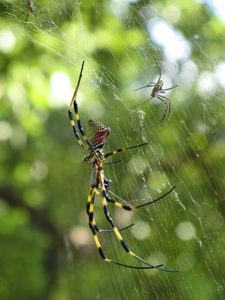 Uh-oh
Uh-oh
Moving right along, the first walk we embarked on is a part of the Kyoto trail, which is a 70 km loop that encircles the city. The whole trail is split up into three sections: East, North, and West, and we have walked along the East section before, both to Fushimi Inari via the trail from our home and in the other direction to Kiyomizu-dera and on to Heian Jingu, the latter of which we did again earlier this year. This time we went to walk part of the northern section, which began at Takao, a sparsely populated, mountainous area with three historic temples located in the area and is a one hour bus ride north from Kyoto station.
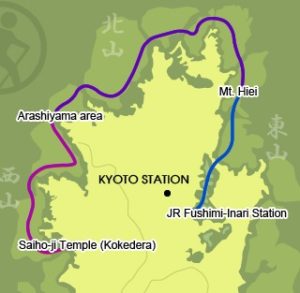 The trail
The trail
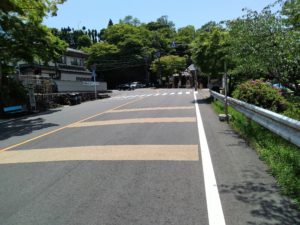
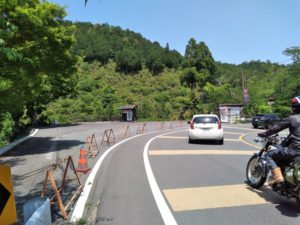
This is where you get off – we were a little perplexed initially
We visited two of the three temples, Saimyo-ji and Jingo-ji – the other temple was a bit further away from the trail. These two temples are part of the Shingon Buddhist sect and are connected in both having a history related to Kukai, who I have mentioned before. Jingo-ji is believed to have been established in the year 824CE as a merger of two private temples. In 812CE, Kukai resided at Takaosan-ji temple, which was the predecessor temple that existed at the current site of Jingo-ji.
Saimyo-ji Temple was founded between 824 and 834CE by Chisen Daitoku, a leading disciple of Kukai, as a branch temple of Jingo-ji Temple. We visited this temple first, which you enter via a bridge over the river Kiyotaki. It is a very small temple and is located in a very verdant setting. Nothing spectacular, but a lovely calm place to visit.
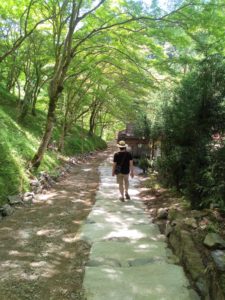
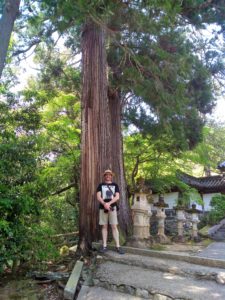
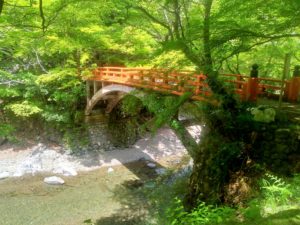
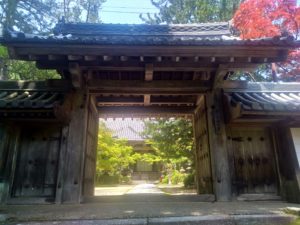
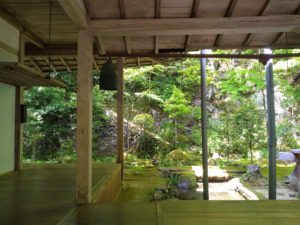
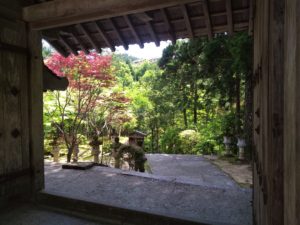
Jingo-ji, on the other hand involves a reasonably strenuous climb up many stairs and is apparently the successor head temple of the Koyasan Shingon sect. It is a big complex covering a large area on Takao-san mountain. The information we had said that there was a place there where you can undertake ‘kawarake-nage’, taking small bowl shaped ceramic cups (kawarake) and throwing them (nageru) from a lookout down into the valley below. The idea is that you transfer your bad luck to the ceramic and it serves as a mayoke, a charm against evil, which you then throw away from you.
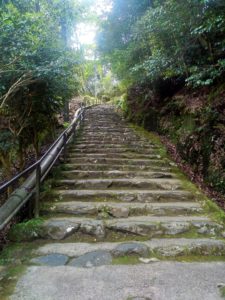
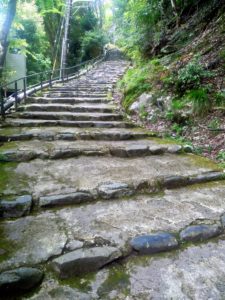
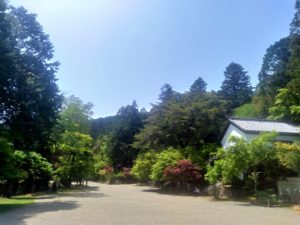
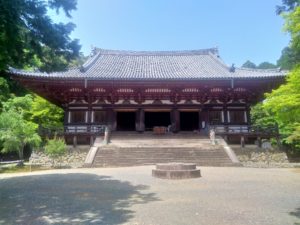
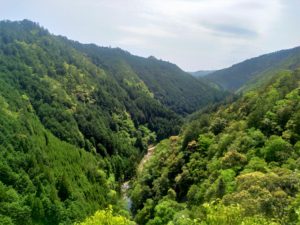
The valley from the lookout
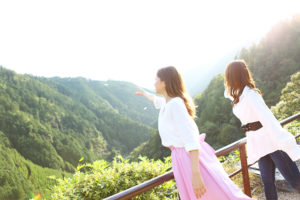
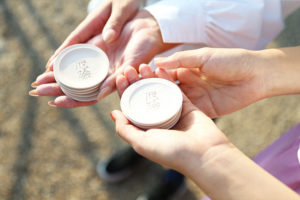
Borrowed photos of people throwing the kawarake – we were so wrapped up in the process we forgot to take photos…
The instructions we had was that the further you throw it the better, and that you should hold it curved side up and throw it like a frisbee. So, this is exactly what we did – we had two each – and the first one for both of us went a long way, off to the left and out of sight into the valley. The woman from the shop where you buy the discs was very excited by how well we did (there was a Japanese woman there also throwing discs, she had a box of them (!) and she wasn’t doing very well at all). On our second throw, both our discs curved to the right, and mine ended up in the trees…but Craig’s went out further and skimmed past them.
After that, we went down into the valley, walking along the river for kms, past long open structures sitting next to the river which are part of local restaurants, across bridges and through forested areas. We actually walked along the valley floor where many of the kawarake end up, some still intact, some not. The track along the river is quite soggy in some areas as water runs from springs out of the valley wall sides into the river. Mostly, however, it is a most pleasant walk.
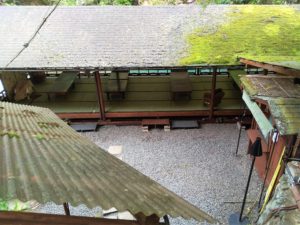
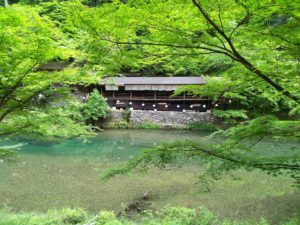
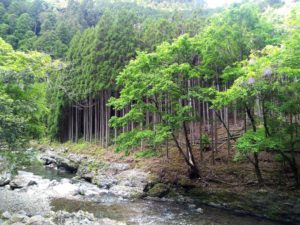
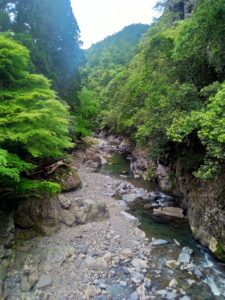
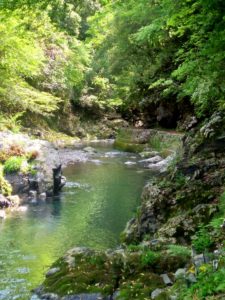
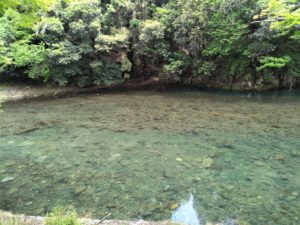
The water in the river was crystal clear
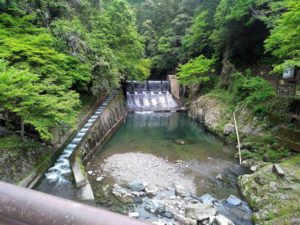
A weir and what appears to be a salmon ladder
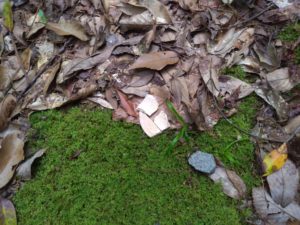
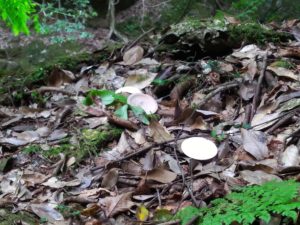
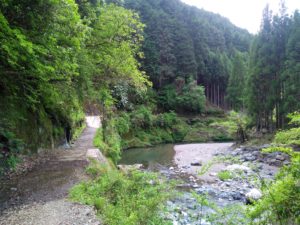
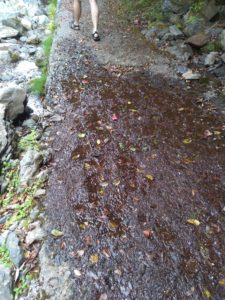
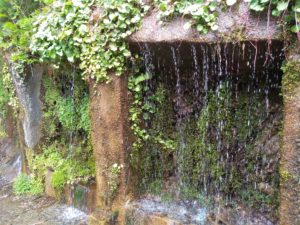
Water pours out of the hillside in spots
A large part of the forest along the route consist of extremely tall and very straight cedar trees, which are supposedly tended to make them like this. As we were walking I suggested it would be perfect to have the song “A Walk in the Black Forest” playing, since we had taken this to Germany with us so that we could walk in the Black Forest with music but it turned out it wasn’t possible to walk in the forest where we stayed (it was very dense and very, very dark). Anyway, as we walked into one stand of trees Craig surprised me by playing it😊. We both quickly fell into the rhythm. Fun.
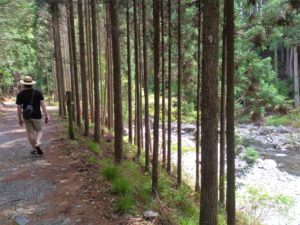
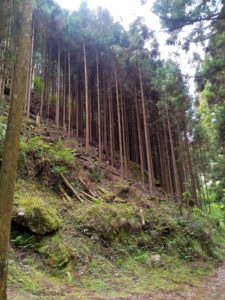
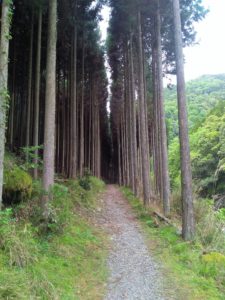
A Walk in the Black(ish) Forest
We decided to take a side track to a waterfall, which took us through another forest, taking over an hour in total, and by the time we got back to the original track it had become overcast and had cooled down a lot – it looked like rain. So, we gave up on finishing this part of trail (which is 11km in total) and went to the nearest bus stop, taking us back to Arashiyama to catch a train back to the station. A really lovely walk, which we will do again, with or without music.
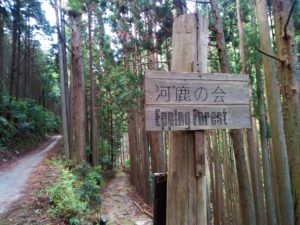
!!!! I didn’t realise quite how far we had walked. Hope there are no highwaymen
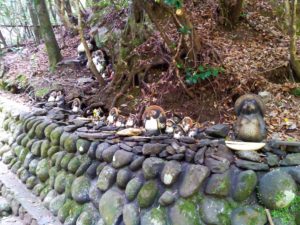
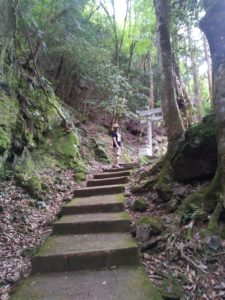 More stairs – to the waterfall
More stairs – to the waterfall
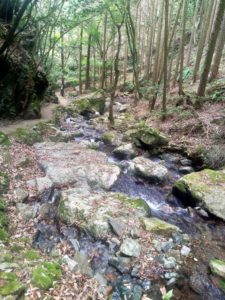
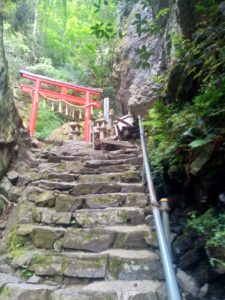
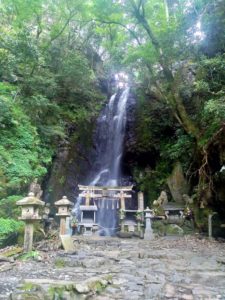
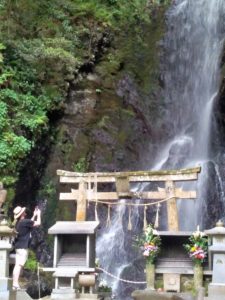
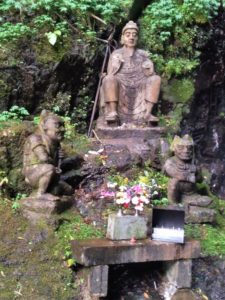


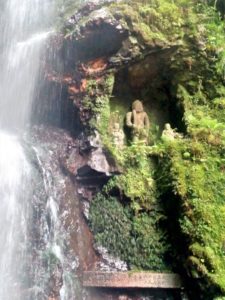
For our other walk I had been wanting to find where the trail went after the end point near Heian Jingu, so we took a bus to start from that point. The trail near our home has a series of post markers along the way, so you can walk it without a map. We found the marker at the point we had finished previously and set off from there. The trail took us up towards Nanzen-ji, but then we couldn’t find the next marker, so continued on toward the Philosopher’s Path, which we reasoned would have to be part of the trail.
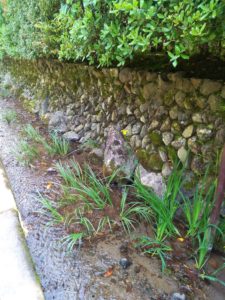
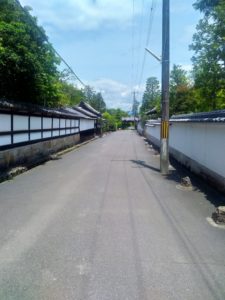
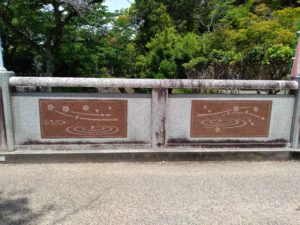
The beginning of the path
Well, we didn’t find any more markers but decided to walk the path because it is a very nice walk, and there were very few people around (unlike spring or autumn). Along the way we came to a bridge and there were two Japanese people standing there with buckets and various bits and pieces. They beckoned us over (while also saying “free”) to show us some small boats they had made with leaves and flowers, which they said we could drop into the canal from the bridge (about 1½ m drop). They gave one to Craig and asked me to select one (I chose one with a yellow and a purple flower, of course), then showed us /how to drop them. We did as they said and they both landed upright and started off in the strong current, at which they w mere very excited and said it was good luck for us (again!). We really do need some good luck for our business…
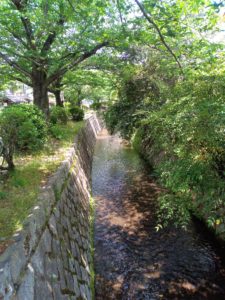
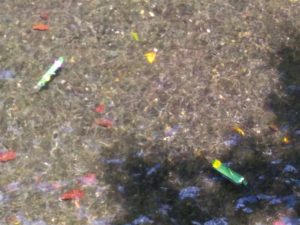
Our little boats – mine had hit an obstacle and was listing
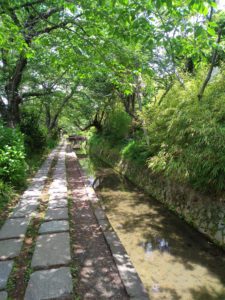
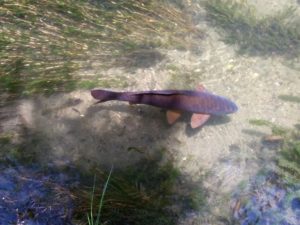
We continued on to Ginkaku-ji (though not inside) and set about finding where the trail up to the diamonji begins, as we’d heard it is a nice hike and didn’t know how to get there. After a quick search we found it, surprisingly it wasn’t very well marked, perhaps they think tourists wouldn’t be interested. In any case, we now know where it is, and that may be our next adventure. Before going home we had our first kakigori (shaved ice sweet) for the season – with matcha syrup, adzuki beans and matcha mochi. Very refreshing.
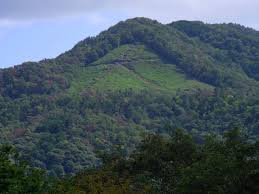 The diamonji
The diamonji
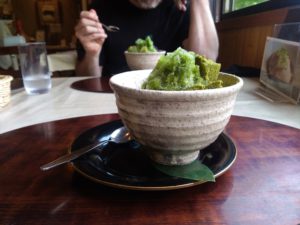
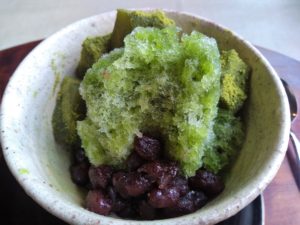
Well, that’s it for this episode – how long will the rainy season last; what will happen next in The virus saga; when will our luck kick in? Who knows, maybe we’ll have some answers by the next episode. Hhhmmmmm
Cheers

I call it rain?
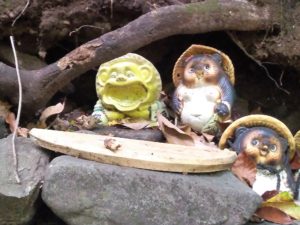
Not sure if the yellow one is a Tanuki..?
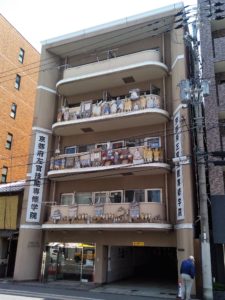
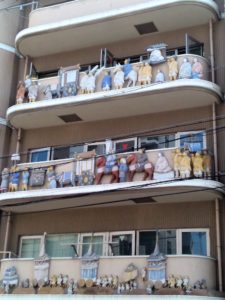
Interesting decorations on a building – The Aoi Matsuri (top 2 levels) and the Gion Matsuri (bottom)
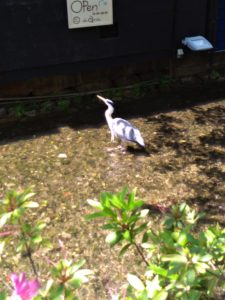 Finally – I hate to queue
Finally – I hate to queue
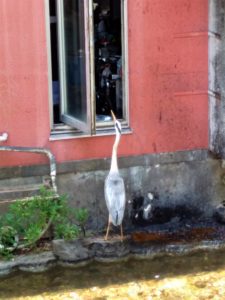 ” I’d like the fish sushi set please”
” I’d like the fish sushi set please”
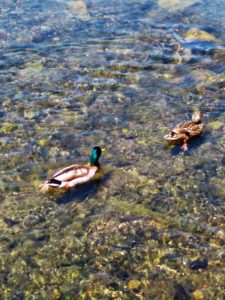 Nice day for an outing
Nice day for an outing
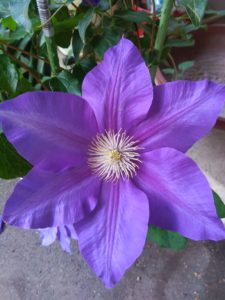

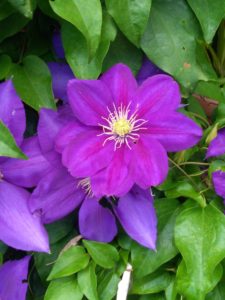
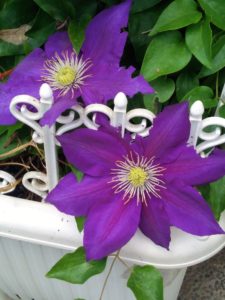
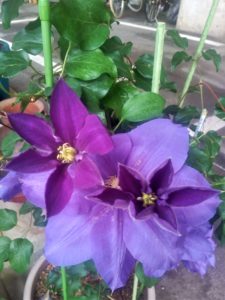
OK, yes I am a little obsessed with clematis. I soooo wish I could grow some
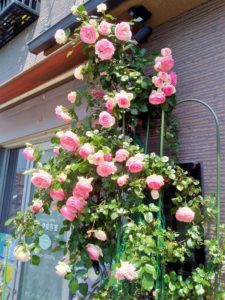
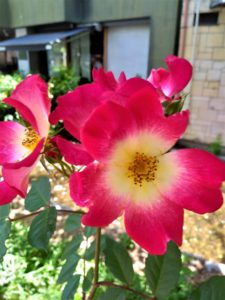
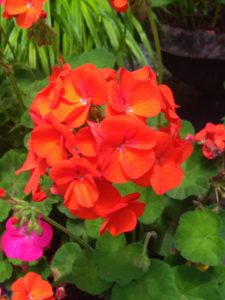
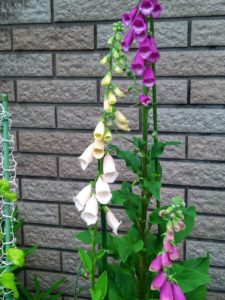
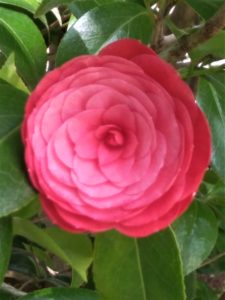
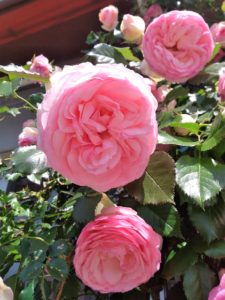
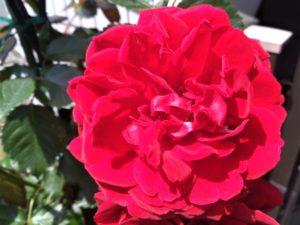

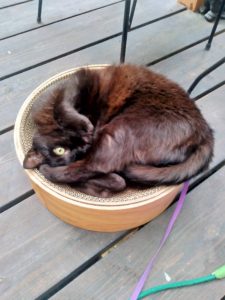 Ziggy nearly fits in there!
Ziggy nearly fits in there!